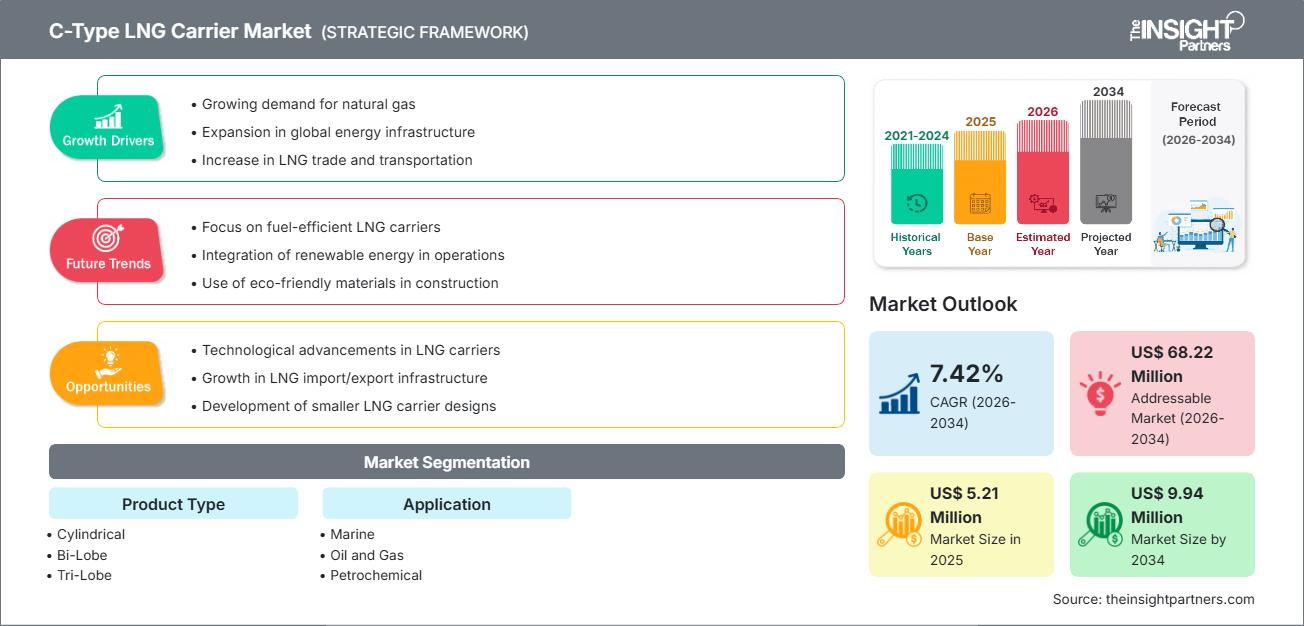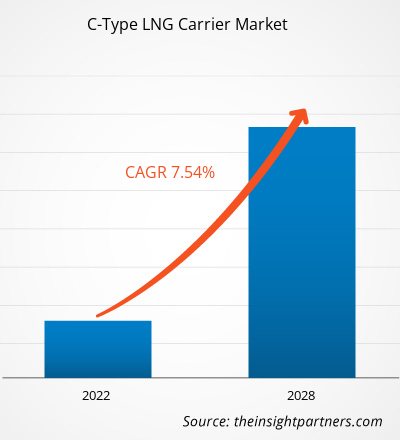Der Markt für LNG-Tanker des Typs C wird voraussichtlich bis 2034 ein Volumen von 9,94 Millionen US-Dollar erreichen, gegenüber 5,21 Millionen US-Dollar im Jahr 2025. Es wird erwartet, dass der Markt im Zeitraum 2026–2034 eine durchschnittliche jährliche Wachstumsrate (CAGR) von 7,42 % verzeichnen wird.
Marktanalyse für LNG-Tanker des Typs C
Der Markt für LNG-Tanker des Typs C wächst aufgrund der steigenden globalen Nachfrage nach Erdgas als saubererem Übergangsbrennstoff und des weltweiten Ausbaus der LNG-Infrastruktur. Diese Tanker, die isolierte, vollständig oder teilweise druckbeaufschlagte zylindrische, zwei- oder dreilappige Tanks nutzen, werden hauptsächlich für kleine bis mittelgroße LNG-Tanker und andere verflüssigte Gase eingesetzt. Sie spielen eine entscheidende Rolle im internationalen LNG-Handel, insbesondere für die regionale Verteilung, die Bunkerung und die Versorgung abgelegener Gebiete. Das Marktwachstum wird durch neue Verflüssigungsprojekte, einen Anstieg neuer Schiffbauaufträge für LNG-betriebene Schiffe und den Bedarf an vielseitigeren Tankern zur Unterstützung des wachsenden Marktsegments für kleinere LNG-Transporte angetrieben.
Marktübersicht für LNG-Tanker des Typs C
Ein LNG-Tanker vom Typ C ist ein Spezialschiff für den Transport von Flüssigerdgas (LNG) bei kryogenen Temperaturen. Die Bezeichnung „Typ C“ bezieht sich auf das Tanksystem, das aus unabhängigen zylindrischen, zwei- oder dreilappigen Druckbehältern besteht, die typischerweise im Schiffsrumpf installiert sind. Diese Bauweise bietet eine erhöhte strukturelle Integrität und Flexibilität beim Ladungsumschlag und ist daher die bevorzugte Wahl für kleinere bis mittlere LNG-Transporte. Der Markt ist geprägt von technologischen Fortschritten mit dem Ziel, die Kraftstoffeffizienz und die ökologische Nachhaltigkeit zu verbessern, beispielsweise durch den Einsatz von Dual-Fuel-Motoren.
Passen Sie diesen Bericht Ihren Anforderungen an.
Sie erhalten eine kostenlose Anpassung aller Berichte – einschließlich Teilen dieses Berichts, Länderanalysen und Excel-Datenpaketen – sowie attraktive Angebote und Rabatte für Start-ups und Universitäten.
Markt für LNG-Tanker des Typs C: Strategische Einblicke

-
Ermitteln Sie die wichtigsten Markttrends dieses Berichts.Diese KOSTENLOSE Probe beinhaltet eine Datenanalyse, die von Markttrends bis hin zu Schätzungen und Prognosen reicht.
Markttreiber und Chancen für LNG-Tanker des Typs C
Markttreiber:
- Weltweit wachsende LNG-Verflüssigungskapazitäten: Der Ausbau von Verflüssigungsanlagen und Exportkapazitäten weltweit, insbesondere in Regionen wie Nordamerika und Russland, führt zu einem ständigen Bedarf an Transportschiffen, um die gestiegenen LNG-Mengen in die Verbraucherregionen zu transportieren.
- Steigende Nachfrage nach Erdgas aus verschiedenen Branchen: Erdgas wird zunehmend als sauberer verbrennende Alternative zu fossilen Brennstoffen für die Stromerzeugung, industrielle Anwendungen und als Schiffstreibstoff (LNG-Bunkerung) eingesetzt, was direkt die Nachfrage nach den notwendigen Transportschiffen antreibt.
- Anstieg neuer Schiffbauaufträge und Flottenerweiterung: Der Bedarf an Flottenmodernisierung zur Einhaltung von Umweltauflagen (wie den IMO 2023 Treibhausgasreduktionsmaßnahmen) und die Erweiterung der LNG-betriebenen Schiffsflotten (einschließlich Containerschiffe und Fähren) kurbeln neue Aufträge für Schiffe des Typs C und andere LNG-Tanker an.
Marktchancen:
- Wachsender Markt für LNG-Kleintransporte: C-Typ-Tanker eignen sich ideal für den Markt für LNG-Kleintransporte, der sich auf die Versorgung abgelegener Gebiete, Industriekunden und die Bereitstellung von LNG als Schiffstreibstoff (Bunkerung) konzentriert. Der Ausbau regionaler LNG-Verteilungsnetze bietet ein bedeutendes Nischenpotenzial.
- Technologische Fortschritte im Flugzeugträgerbau: Es bieten sich Möglichkeiten in der Entwicklung und Integration neuer Technologien, wie z. B. treibstoffeffizientere und umweltfreundlichere Schiffskonstruktionen sowie KI- und digitale Systeme zur Schiffsoptimierung, vorausschauenden Wartung und Echtzeit-Datenanalyse, um die Betriebskosten und die Umweltbelastung zu reduzieren.
- Ausbau der LNG-Infrastruktur: Investitionen in neue Importterminals, Regasifizierungsanlagen und LNG-Bunkerzentren weltweit schaffen Möglichkeiten für C-Type-Tanker, diese neuen Infrastrukturpunkte zu bedienen.
Marktbericht für LNG-Tanker des Typs C: Segmentierungsanalyse
Der Marktanteil von LNG-Tankern des Typs C wird in verschiedenen Segmenten analysiert, um ein besseres Verständnis seiner Struktur, seines Wachstumspotenzials und der sich abzeichnenden Trends zu ermöglichen. Nachfolgend ist der in den meisten Branchenberichten verwendete Standard-Segmentierungsansatz dargestellt:
Nach Produkttyp:
- Zylindrisch
- Bi-Lobe
- Dreilappen
Auf Antrag:
- Marine
- Öl und Gas
- Petrochemische
Nach Geographie:
- Nordamerika
- Europa
- Asien-Pazifik
- Süd- und Mittelamerika
- Naher Osten und Afrika
Markt für LNG-Tanker des Typs C – Regionale Einblicke
Die regionalen Trends und Einflussfaktoren auf den Markt für LNG-Tanker des Typs C im gesamten Prognosezeitraum wurden von den Analysten von The Insight Partners eingehend erläutert. Dieser Abschnitt behandelt außerdem die Marktsegmente und die geografische Verteilung des Marktes für LNG-Tanker des Typs C in Nordamerika, Europa, Asien-Pazifik, dem Nahen Osten und Afrika sowie Süd- und Mittelamerika.
Marktbericht über LNG-Tanker des Typs C – Umfang
| Berichtattribute | Details |
|---|---|
| Marktgröße im Jahr 2025 | 5,21 Millionen US-Dollar |
| Marktgröße bis 2034 | 9,94 Millionen US-Dollar |
| Globale durchschnittliche jährliche Wachstumsrate (2026 - 2034) | 7,42 % |
| Historische Daten | 2021-2024 |
| Prognosezeitraum | 2026–2034 |
| Abgedeckte Segmente |
Nach Produkttyp
|
| Abgedeckte Regionen und Länder |
Nordamerika
|
| Marktführer und wichtige Unternehmensprofile |
|
Marktdichte der Akteure im Markt für LNG-Tanker des Typs C: Auswirkungen auf die Geschäftsdynamik verstehen
Der Markt für LNG-Tanker des Typs C wächst rasant, angetrieben durch die steigende Nachfrage der Endverbraucher. Gründe hierfür sind unter anderem sich wandelnde Verbraucherpräferenzen, technologische Fortschritte und ein wachsendes Bewusstsein für die Vorteile des Produkts. Mit steigender Nachfrage erweitern Unternehmen ihr Angebot, entwickeln innovative Lösungen, um den Kundenbedürfnissen gerecht zu werden, und nutzen neue Trends, was das Marktwachstum zusätzlich beflügelt.

- Verschaffen Sie sich einen Überblick über die wichtigsten Akteure auf dem Markt für LNG-Tanker des Typs C.
Marktanteilsanalyse für LNG-Tanker des Typs C nach Regionen
Für den asiatisch-pazifischen Raum wird im Prognosezeitraum ein starkes Wachstum erwartet, wodurch er den größten Marktanteil einnehmen wird. Diese Dominanz ist auf die massive und stetig steigende Nachfrage nach Erdgas in der Region, das hohe industrielle Wachstum und die zunehmende Nutzung sauberer Energiequellen zurückzuführen. China leistet einen wichtigen Beitrag zum Markt, ist aber nach wie vor stark von ausländischen LNG-Tankern abhängig.
Der Markt für LNG-Tanker des Typs C weist aufgrund von Faktoren wie dem Anstieg neuer Schiffbauaufträge und der Erweiterung der Flotte in den einzelnen Regionen unterschiedliche Wachstumsverläufe auf. Nachfolgend finden Sie eine Zusammenfassung der Marktanteile und Trends nach Regionen:
-
Nordamerika
- Marktanteil: Besitzt einen beträchtlichen Marktanteil, der auf seiner Position als bedeutender LNG-Exporteur beruht.
-
Wichtigste Einflussfaktoren:
- Deutlicher Ausbau der LNG-Exportkapazitäten in den USA und Kanada.
- Präsenz bedeutender LNG-Hersteller und robuste Investitionen des Schifffahrtssektors in LNG-Anlagen.
- Fokus auf LNG als saubere Energiequelle.
- Trends: Investitionen in inländische LNG-Transportanlagen wie LNG-Bunkerschiffe.
-
Europa
- Marktanteil: Ein wichtiger Markt mit steigender Verflüssigungs- und Regasifizierungskapazität.
-
Wichtigste Einflussfaktoren:
- Starker Fokus auf Energiesicherheit und Diversifizierung der Gasversorgung.
- Strengere Umweltauflagen (z. B. IMO-Regeln) beschleunigen die Einführung von LNG-betriebenen Schiffen.
- Nachfrage nach neuen Dienstleistungen (z. B. Kleinverteilung) an bestehenden LNG-Importterminals.
- Trends: Investitionen in neue LNG-Tanker, einschließlich Eisbrecher für Arktisrouten, und eine Verlagerung hin zu Dual-Fuel- und umweltverträglichen Schiffen.
-
Asien-Pazifik
- Marktanteil: Es wird erwartet, dass es sich um den am schnellsten wachsenden regionalen Markt handelt und dass dieser aufgrund der enormen Nachfrage nach LNG-Importen einen bedeutenden Marktanteil hält.
-
Wichtigste Einflussfaktoren:
- Rasantes industrielles Wachstum und steigender Energiebedarf.
- Staatlich geförderte Einführung saubererer Energiequellen wie LNG.
- Hohes LNG-Importvolumen, insbesondere in China und Indien.
- Trends: Dominanz des Schifffahrtssegments bei der Anwendung. Starker Fokus auf den Aufbau von Regasifizierungskapazitäten.
-
Süd- und Mittelamerika
- Marktanteil: Aufstrebender Markt mit zunehmender Akzeptanz.
-
Wichtigste Einflussfaktoren:
- Steigender Energiebedarf und Erschließung von Gasfeldern.
- Investitionen in die regionale LNG-Infrastruktur und Importanlagen.
- Trends: Entwicklung automatisierter Übersetzungstools für mehrsprachige Zielgruppen, prädiktive KI zur Kampagnenoptimierung und Social-Listening-Plattformen.
-
Naher Osten und Afrika
- Marktanteil: Aufstrebender Markt mit starkem Wachstumspotenzial.
-
Wichtigste Einflussfaktoren:
- Wichtige nationale Digital- und Energiestrategien zur Förderung von Innovationen im Gastransport.
- Wichtige Akteure wie Katar dominieren weiterhin den globalen LNG-Handel und treiben die Nachfrage nach neuen Tankern an.
- Trends: KI-gestütztes Tracking der Publikumsstimmung, Aufdeckung von Influencer-Betrug und mehrsprachige Inhaltsmoderation durch maschinelles Lernen.
Marktdichte der Akteure im Markt für LNG-Tanker des Typs C: Auswirkungen auf die Geschäftsdynamik verstehen
Der Markt für LNG-Tanker des Typs C ist hart umkämpft. Einige wenige große globale Schiffbau- und Reedereien dominieren die Neubauaufträge und den Flottenbetrieb. Die Differenzierung erfolgt primär durch technologische Innovationen, die Einhaltung strenger Umweltauflagen und strategisches Flottenmanagement.
Der Wettbewerb zwingt die Anbieter dazu, sich durch Folgendes zu differenzieren:
- Investitionen in fortschrittliche Auffangsysteme und treibstoffsparende Antriebe zur Reduzierung von Kraftstoffverbrauch und Emissionen.
- Kooperationen zwischen Schiffbauern, Technologieanbietern und großen Energieunternehmen zur Sicherung langfristiger Verträge und Finanzierungen für neue Schiffe.
- Wir zielen auf das wachsende Marktsegment ab, das kleinere, vielseitigere C-Type-Transportschiffe für regionale Verteilungs- und Bunkerdienste benötigt.
Chancen und strategische Schritte
- Flottenmodernisierung und -erweiterung: Unternehmen bestellen kontinuierlich neue Schiffe, um ältere, weniger effiziente Einheiten zu ersetzen und die Kapazität zu erweitern, um dem wachsenden globalen LNG-Handelsvolumen gerecht zu werden.
- Integrierte Wertschöpfungskette: Große Energieunternehmen und Reedereien integrieren ihre Geschäftstätigkeiten entlang der gesamten LNG-Wertschöpfungskette, von der Verflüssigung über den Transport bis hin zum Vertrieb.
- Einführung digitaler und autonomer Technologien: Entwicklung und Integration intelligenter Versandlösungen (KI, IoT, Fernüberwachung) zur Steigerung der betrieblichen Effizienz, der Sicherheit und der vorausschauenden Wartung.
Die wichtigsten Unternehmen, die auf dem Markt für LNG-Tanker des Typs C tätig sind, sind:
- China Shipbuilding Trading Co., Ltd
- DSME Co., Ltd
- GAS Entec
- Gaslog Ltd
- HYUNDAI SAMHO HEAVY INDUSTRIES CO., LTD.
- Knutsen OAS Shipping
- Komarine Co
- Mitsubishi Heavy Industries, Ltd.
- TGE Marine Gas Engineering GmbH
Hinweis: Die oben aufgeführten Unternehmen sind nicht in einer bestimmten Reihenfolge geordnet.
Marktneuigkeiten und aktuelle Entwicklungen für LNG-Tanker des Typs C
- So gab HD KSOE beispielsweise im November 2024 bekannt, dass sie Schiffbauverträge über insgesamt 25 Schiffe mit ausländischen Unternehmen in Europa, Ozeanien, Asien und dem Nahen Osten unterzeichnet hat. Die Verträge umfassen zwei sehr große Ammoniaktanker (VLAC), 15 mittelgroße Produktentanker (PC), sechs sehr große Flüssiggastanker (VLGC) und zwei Flüssigerdgastanker (LNG). Das Gesamtvolumen der Verträge beträgt 2,82 Billionen KRW.
Marktbericht für LNG-Tanker des Typs C: Abdeckung und Ergebnisse
Der Bericht „Marktgröße und Prognose für LNG-Tanker des Typs C (2021–2034)“ bietet eine detaillierte Analyse des Marktes, die folgende Bereiche abdeckt:
- Marktgröße und Prognose für LNG-Tanker des Typs C auf globaler, regionaler und Länderebene für alle wichtigen Marktsegmente, die im Geltungsbereich abgedeckt werden
- Markttrends für LNG-Tanker des Typs C sowie Marktdynamiken wie Treiber, Hemmnisse und wichtige Chancen
- Detaillierte PEST- und SWOT-Analyse
- Marktanalyse für LNG-Tanker des Typs C: Analyse der wichtigsten Markttrends, des globalen und regionalen Rahmens, der Hauptakteure, der regulatorischen Rahmenbedingungen und der jüngsten Marktentwicklungen
- Branchenlandschaft und Wettbewerbsanalyse mit Fokus auf Marktkonzentration, Heatmap-Analyse, führende Akteure und aktuelle Entwicklungen im Markt für LNG-Tanker des Typs C. Ausführliche Unternehmensprofile.
- Historische Analyse (2 Jahre), Basisjahr, Prognose (7 Jahre) mit CAGR
- PEST- und SWOT-Analyse
- Marktgröße Wert/Volumen – Global, Regional, Land
- Branchen- und Wettbewerbslandschaft
- Excel-Datensatz
Aktuelle Berichte
Erfahrungsberichte
Grund zum Kauf
- Fundierte Entscheidungsfindung
- Marktdynamik verstehen
- Wettbewerbsanalyse
- Kundeneinblicke
- Marktprognosen
- Risikominimierung
- Strategische Planung
- Investitionsbegründung
- Identifizierung neuer Märkte
- Verbesserung von Marketingstrategien
- Steigerung der Betriebseffizienz
- Anpassung an regulatorische Trends






















 Kostenlose Probe anfordern für - Markt für LNG-Tanker des Typs C
Kostenlose Probe anfordern für - Markt für LNG-Tanker des Typs C